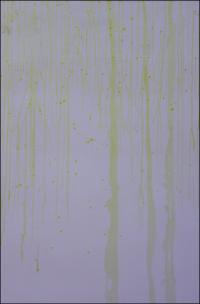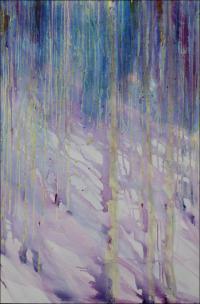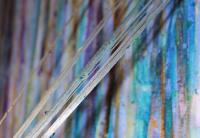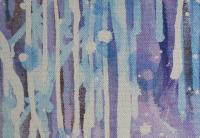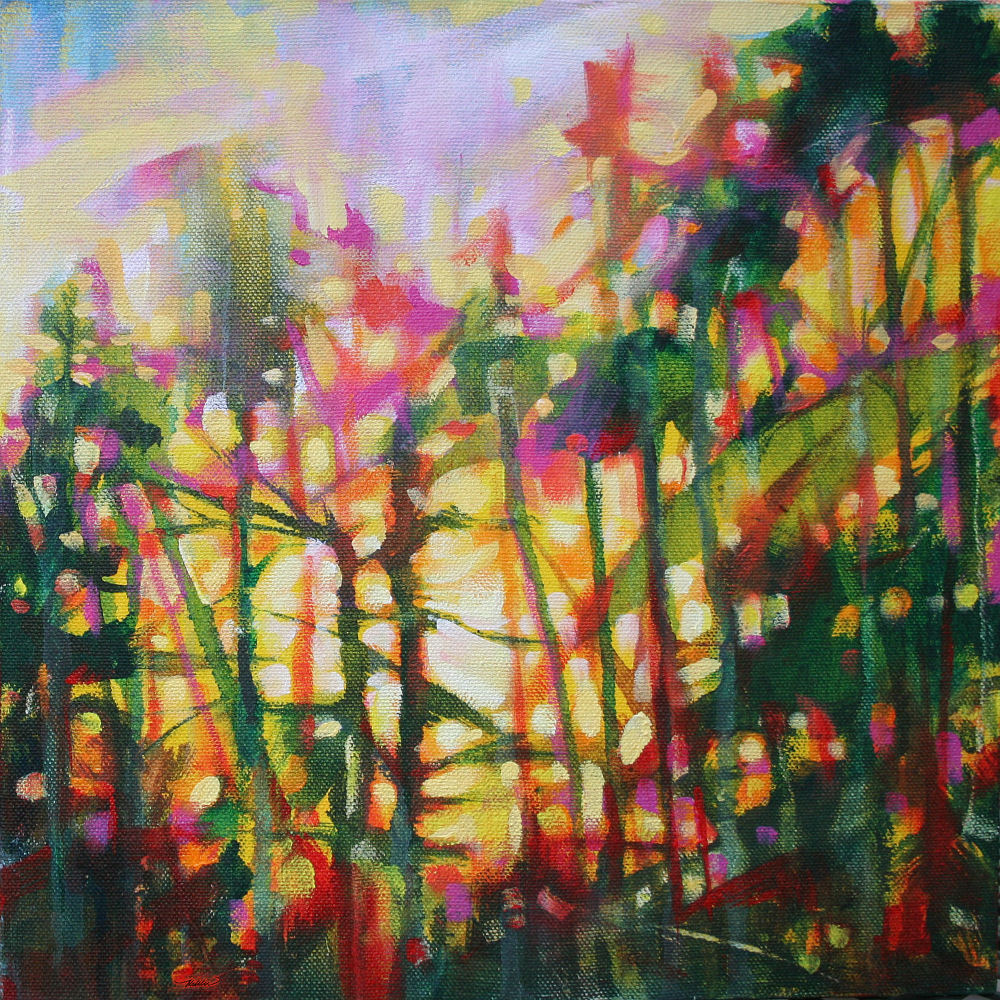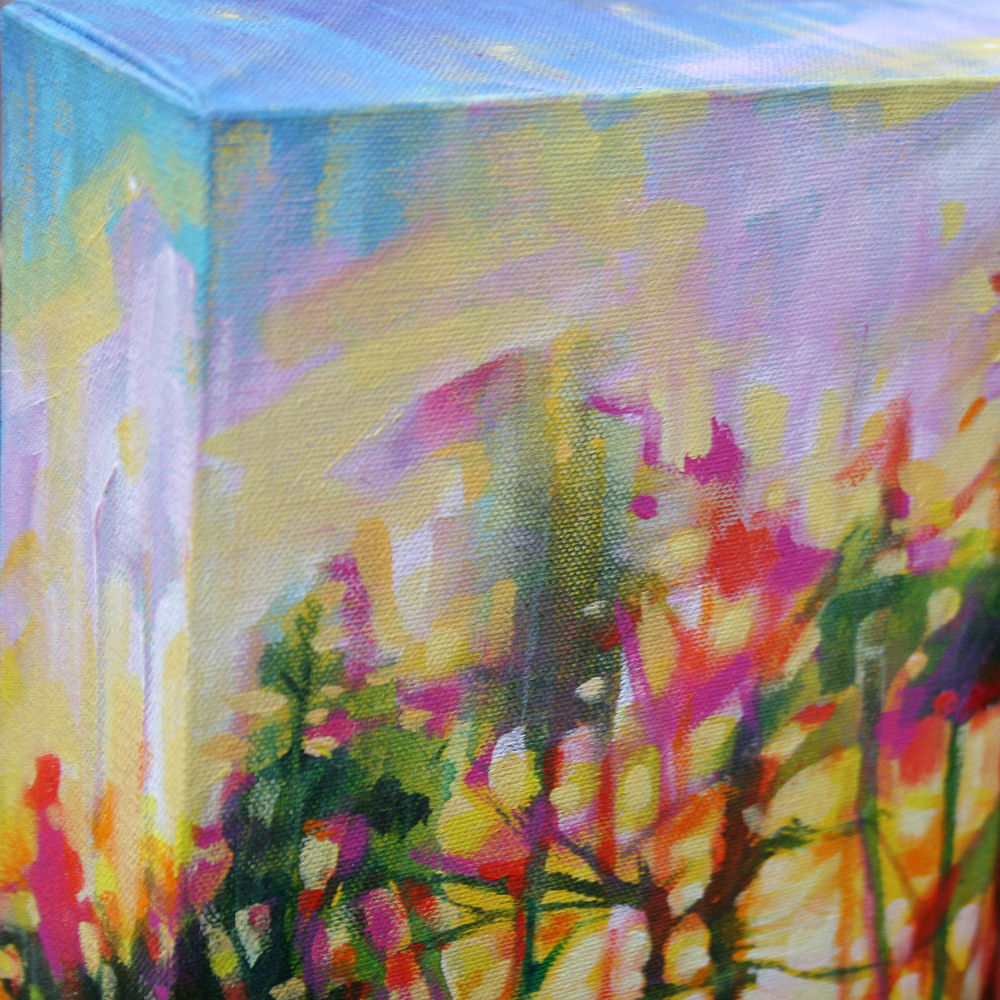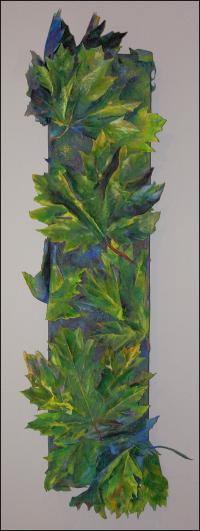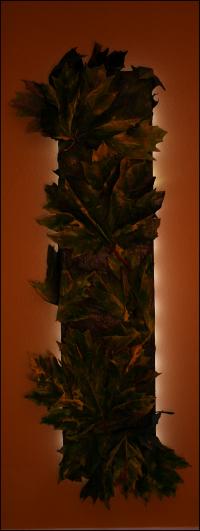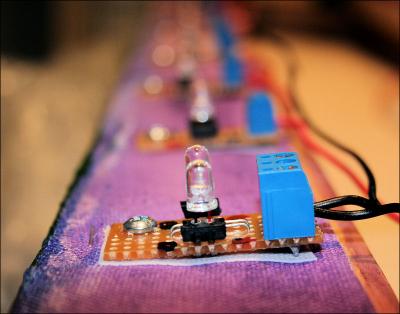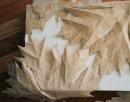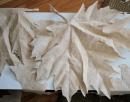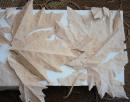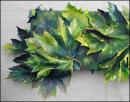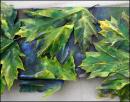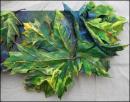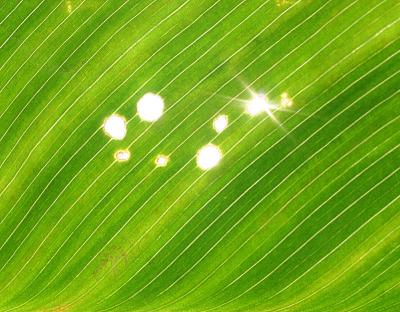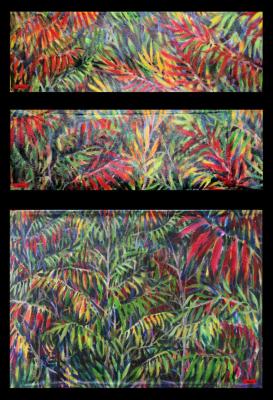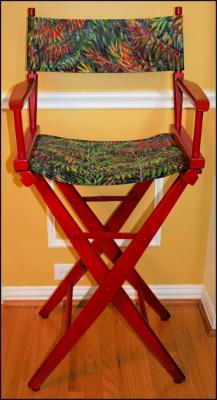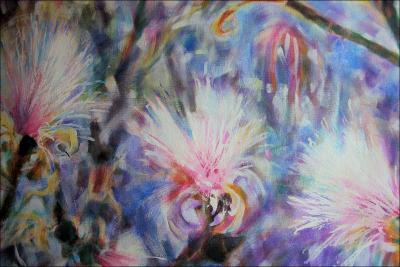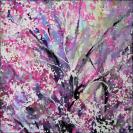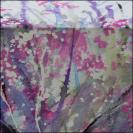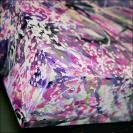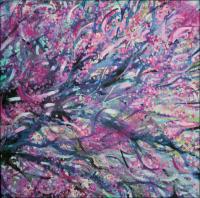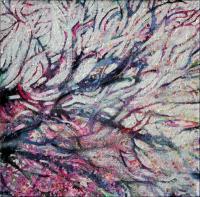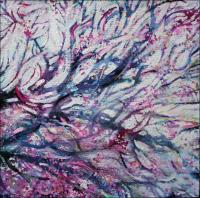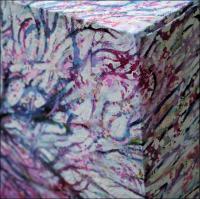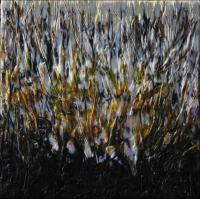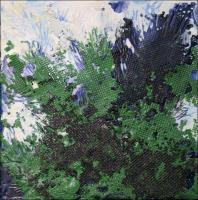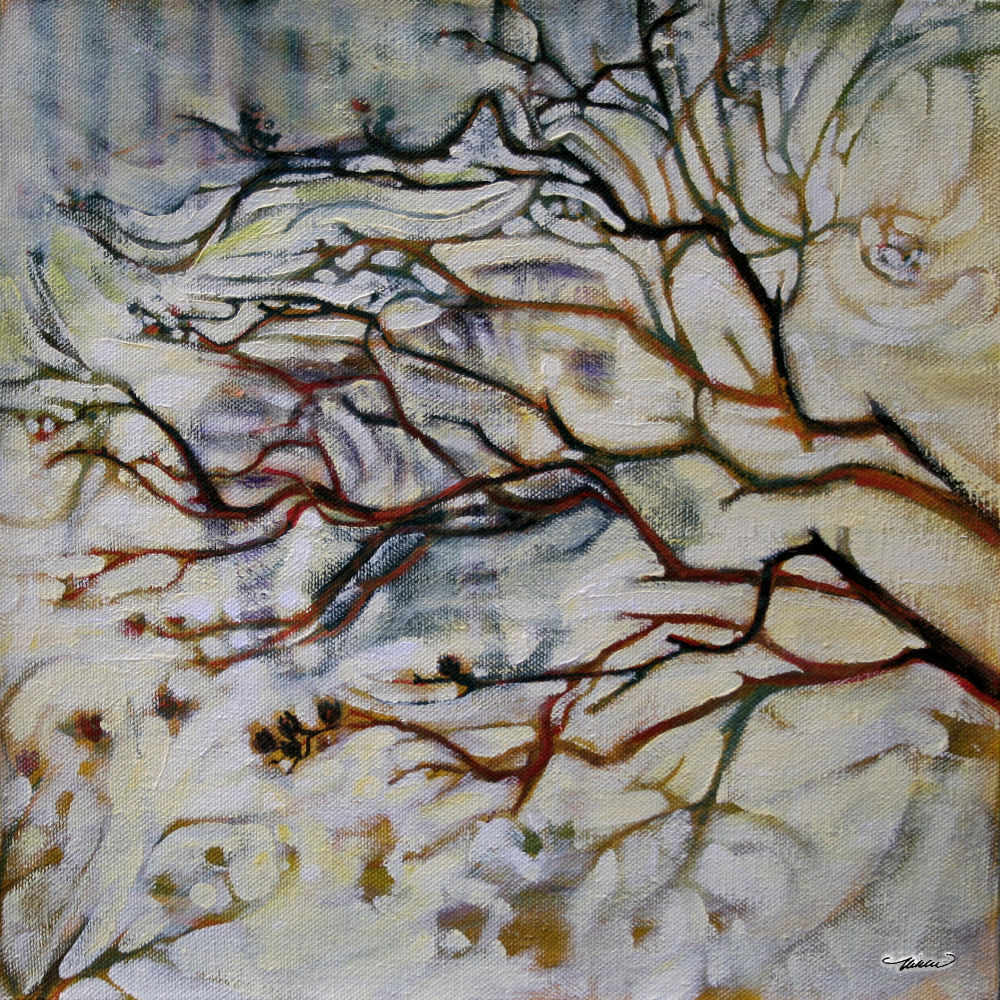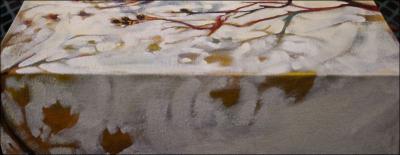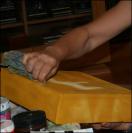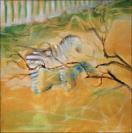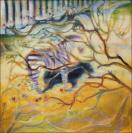Seasonal
« Previous Entries Next Entries »The Sound of Silence
Thursday, October 15th, 2009
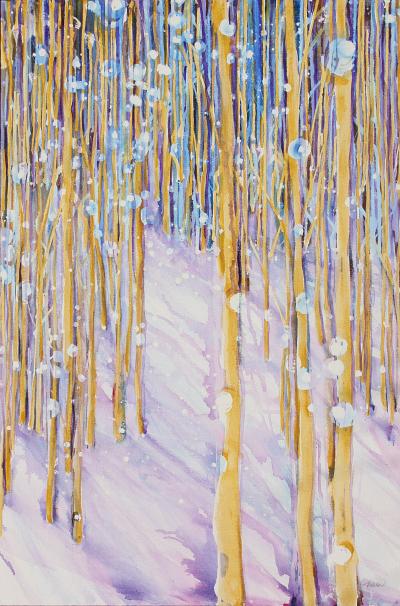
The Sound of Silence, 36H x 24W x 2D inches acrylics on canvas, wrapped sides painted, narrow frame – finished today. After a second application of mask medium only on the snowflakes this time, some unbleached titanium and yellow ochre brought color back to the trunks. Snowflake mask was then removed.
Oct 13th, above: Phase 01 and 02
Oct 14th, Phase 03 and 04: Mask medium removal, then highlighting snowflakes.
500X Gallery: Landscape
Tuesday, October 6th, 2009
Saint Catherine’s Sunset, Ontario, Canada – 11H x 11W x 3D acrylics on canvas, wrapped sides painted, showingOctober 1 0 – 31st, 2009 500X Gallery Open Show: Landscape, 500 Exposition Ave. Dallas, TX. Opening Reception Saturday, October 10th, 7:00 p.m. – 10:00 p.m.
Oxide Gallery 1st Year Anniversary celebration today, Tuesday October 6th, 6:00 p.m. – 9:00 p.m. Happy Anniversary Oxide Gallery!
I’ll be giving a demo on the use of Masking Fluid in acrylics paintings, so come and reveal one painting by helping to peel off the rubberized mask – I don’t even know what it looks like underneath, so it will be a surprise for all of us. Techniques on applying the fluid will be demonstrated on another painting already in progress. Three pieces accepted in the current show at Oxide Gallery are:
What Bigleaf Maples Do At Night
Monday, May 25th, 2009
What Bigleaf Maples Do At Night, 57H x 20W x 4D inches muslin, glue, acrylics on canvas wrapped over custom-built stretcher frame. LED light system in back.
Alain, my husband, signed his name on this also, because he spent the entire week designing, soldering and wiring a system of 30 LED lights for the back. He was not impressed with the eight inadequate push-lights I was initially going to use to create this Day- Night Art. The electric source is a rechargeable 12 volt battery placed neatly in the back, with an easily accessible on-off switch in the lower left corner. He’s not thrilled to ever create another, so it looks like I’ll be learning a little about soldering and electronics, because there are plans to transform the other two canvases exactly the same size as this one. Originally l hoped it could hang in any of four orientations, but that was revised due the battery pack in the back. Thank you Alain for making this piece what it is!
______________________The original blog posts; process:___________________
Nov. 17th, 2008: While finishing the final stages of Sun Shower #4, at this point more study than stroke, I’ve started on the next piece… a bit of mystery thrown into this one just for fun. Hint: Step 1 – Unbleached muslin is painted with glue; place over top parchment paper and turn or lift frequently so it doesn’t stick. Nov. 18th: Step 2– When dry the muslin becomes stiff and can be crumpled, pinched and maneuvered to create 3D textures.
Nov 18th, aft. Step 3 – OK, enough guessing. I have three beautiful sturdy 36 x 12 x 3 inch canvases, hung vertically or horizontally. Each one will have a 3D design of life-sized leaves created with the stiff muslin. This one is of Large Leaf Maples seen on salt Spring Island, B.C. when we were there last summer. They are really this big – about 15 inches across! On these canvases, all dimensional surfaces will be considered; the front, the sides, and possibly some sticking out from the back. Everything will be primed before painting and I love Virginia’s idea to use glue as a resist for the leaf veins. In the above three images the design is still in planning stages.
Nov. 19th – A few thoughts before continuing work: this could be as simple as a sillhouette or painted realistically, still haven’t decided..maybe a compromise of the two, on the abstract side of things. Putting lights in the back could be interesting too, as in the recent Zen Garden #8 but would like to come up with something that does not have a distracting cord.
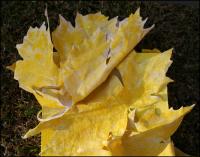 Nov.21st – Seen here, the leaves have a splotchy base coat of Hansa Yellow Deep, a color chosen because when it is so vibrant when it peeks through built up layers of other colors. Now that the entire piece has color though, I think I prefer the sculptural purity of the unpainted sillhouettes better – something to remember for similar work in the future.
Nov.21st – Seen here, the leaves have a splotchy base coat of Hansa Yellow Deep, a color chosen because when it is so vibrant when it peeks through built up layers of other colors. Now that the entire piece has color though, I think I prefer the sculptural purity of the unpainted sillhouettes better – something to remember for similar work in the future.
The weight of tinted primer and each application of acrylics makes the fabric limp from of the paint, meaning the creasing process needs to be done all over again once it dries, even on successive layers. Because of this I need to slow down and be more gentle with the painting process also. It’s funny how you can overlook things like that when you are ten steps ahead with anticipation for a new project; things always take much longer than you imagine. There is going to be a lot of stopping and starting with this one, which is exactly how overlapping projects occurs.
Also: looking forward to a day-long workshop tomorrow, learning about Encaustic painting with Deanna Wood. Encaustics is an ancient process of painting with beeswax and natural resins. Not usually a “workshop” kind of Artist because I’m too greedy with my work-time, but this is one of those things that’s best learned from an expert. Am bringing a fabric leaf to the class to see how it could be incorporated and if this entire. Large Leaf Maples piece could benefit.
______________________________
All posts and comments for this piece are now combined.
Submitted on 2008/11/18 at 11:48am
If you don’t want to see the seed bits in the muslin, you can get unbleached muslin without the seeds.
_______________________________
Submitted on 2008/11/18 at 1:03pm
OK Lynda, thanks for offering this valuable tip. With regard to what’s in mind for this project, the rawness of the fabric will provide extra texture, but others may want to know that finer quality muslin is available.
Nikki
_______________________________
Submitted on 2008/11/18 at 1:53pm
Hmmm…looks like a resist process to me. Is it a mask? You are a very adventurous soul!
Virginia Wieringa
_______________________________
Submitted on 2008/11/18 at 2:06pm
Nope, not a mask or resist…at least the glue wasn’t initially going to be used as a resist, but once again I owe thanks for the tip via a viewer’s comment – thanks Virginia! It’s true, glue can be used on anything as a paint resist, usually on wood it works similar to crackle glaze (ask me how if anyone is interested). I haven’t tried that technique on raw fabric yet though and for what I have in mind, painting extra glue in strategic places could produce some interesting effects. Let’s see…
Nikki
_______________________________
Submitted on 2008/11/19 at 1:16am
This is great Nikki. I’ll be back tomorrow to see how this project is coming along.
Jim Drury
_______________________________
Submitted on 2008/11/19 at 4:12pm
Hi Nikki
This is getting really interesting, can’t wait to see the finish project
Elizabeth
_______________________________
Submitted on 2008/11/19 at 7:07pm
Thanks for staying tuned Dad and Elizabeth, I also can’t wait to see the finished project – it’s always a mystery even if I think I know what I’m doing.
Nikki
_______________________________
Nov.27: What Large Leaf Maples Do At Night, detail images of 12 x 36 x 3 inches Muslin, glue, acrylics on wrapped canvas. As seen here I imagined the leaves glowing in the moonlight, which took me to the idea of turning it into a piece that can be viewed differently in a dark corner or at night so the sculptural sillhouette shows best.
Since Saturday’s Encaustics workshop I’d like to try another sculptural piece doing the whole thing with 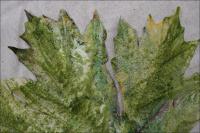 Encaustics tecniques, see right sample. Beeswax doesn’t adhere to acrylics though, so another will need to be planned with that medium in mind right from the start.
Encaustics tecniques, see right sample. Beeswax doesn’t adhere to acrylics though, so another will need to be planned with that medium in mind right from the start.
A New Solar System
Wednesday, May 13th, 2009
Not much artwork to be posted this past week or for the next two weeks because of all the printing and finalizing details for The Majesty of Trees, so I might as well post another link to the website and promote the show one more time.
Meanwhile, taking photos is still a daily activity because there’s always something beautiful somewhere, and it sure is a nice way to take a break..
Sumac Bushes Chair finished
Tuesday, May 5th, 2009
Sumac Bushes, 47H x 22W x 16D inches refurbished Director’s Chair, acrylics on canvas.
Four cropped pieces of the 1999 painting that inspired this chair hang above it, updated and framed with red narrow plastic w/glass frames. The chair and small paintings are a set.
The perfect place for masking fluid
Monday, April 13th, 2009
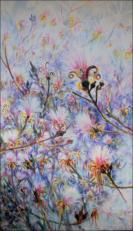 Flowering Shavingbrush Tree, April 11th above: details of 85H x 45W x 3D inches acrylics on canvas,wrapped sides painted, trim frame. Still in progress, but the rubberized mask was removed in order to see exactly what stage things are at before continuing. The painting overall still has a few areas to open up; very little work tomorrow should finish it. Shortly after starting the painting I turned it upside down and applied the masking fluid with a toothpick and let it drip. Gravity can be used as a tool!
Flowering Shavingbrush Tree, April 11th above: details of 85H x 45W x 3D inches acrylics on canvas,wrapped sides painted, trim frame. Still in progress, but the rubberized mask was removed in order to see exactly what stage things are at before continuing. The painting overall still has a few areas to open up; very little work tomorrow should finish it. Shortly after starting the painting I turned it upside down and applied the masking fluid with a toothpick and let it drip. Gravity can be used as a tool!
April 13th, Left: The top third will still leave as much of the primed canvas as possible; a gradation of unfinished space toward more finished at the bottom. I was hoping to leave it as seen here giving an airy illusion, but it does need to develop along with the rest of it…still not as much, but enough to show the main flower better. This means I’ll be once again dripping masking fluid on the piece upside down to preserve the interesting marks that occurred from the 1st application, and also create some new ones with any further work. For previous posts on earliest progress of this painting click here.
Eastern Redbuds
Saturday, April 11th, 2009
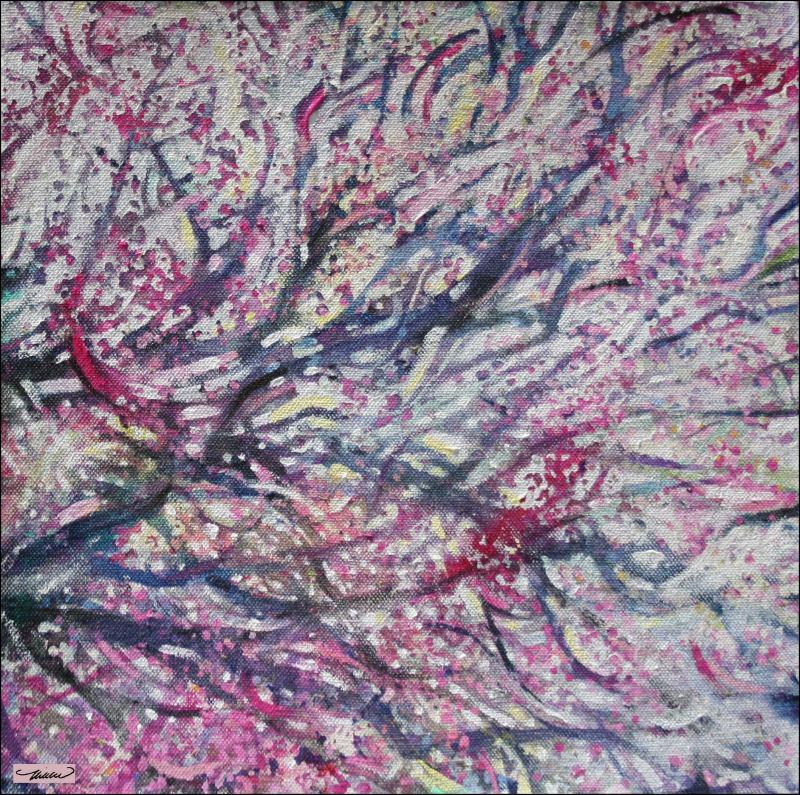
Eastern Redbuds – Spring in Dallas, TX – finished April 11, 2009, took off all remaining masking fluid. 11H x 11W x 3D inches, acrylics on canvas, wrapped sides painted. Signature is on the side, so one is superimposed here on the front. Hang on a wall or display on a flat surface.
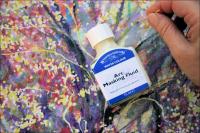 Eastern Redbuds is the first of sixteen 11H x 11W x 3D inches acrylics on canvas paintings of various aspects of trees, to hang together as a group or flanking other paintings. This one uses masking medium to block out areas of white. The first layer of dried medium was removed in the above thumbnails. Afternoon post, left: Adding another layer of masking fluid, seen as yellow.
Eastern Redbuds is the first of sixteen 11H x 11W x 3D inches acrylics on canvas paintings of various aspects of trees, to hang together as a group or flanking other paintings. This one uses masking medium to block out areas of white. The first layer of dried medium was removed in the above thumbnails. Afternoon post, left: Adding another layer of masking fluid, seen as yellow.
Feb. 25th: below left, looks better turned on its side but it could be hung either direction, mask was removed then the painting was overworked unintentionally – all the marks that were the whole point of using masking fluid are hardly visible.
So on Feb. 26th: below right, more mask was applied, then white painted between branches, tore away a few select areas of the dried mask and left the rest on as texture.
The Shavingbrush Tree
Thursday, April 9th, 2009
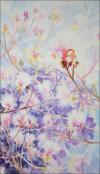 The Shavingbrush Tree in front of a flowering Jacaranda tree seen in Chapala, Mexico, 85H x 45W x 3D inches acrylics on canvas, wrapped sides painted, work in progress. Thumbnail, left: started March 31st
The Shavingbrush Tree in front of a flowering Jacaranda tree seen in Chapala, Mexico, 85H x 45W x 3D inches acrylics on canvas, wrapped sides painted, work in progress. Thumbnail, left: started March 31st
The last painting helped me more aware of how powerful contrasts of light and dark can be. Here, areas of primer will be purposely be left unpainted. I was going to just carefully avoid the white areas and paint around them, but during the second phase I dripped some of the masking fluid to block out a few details in the main flowers. Already it is a very different painting process-wise; right from the start it has felt like a complicated puzzle; that stage doesn’t usually appear until near finishing. The first stages of painting are usually the most liberating but since I never pencil in an outline before painting, I fought a lazy brain right from the start that did not want to map out the placement… which doesn’t make sense because I really really want to paint this one! These are not typically the colors I use either, so there are a few intimidating factors. I hope to maintain fresh, bright Easter colors — partly because this is when they bloom in Mexico. Painting is much like a runner hitting “the wall” but persevering and breaking through it…however in painting there are many walls to conquer.
Oxide Gallery
There are a few pieces hanging at Oxide Gallery, Denton, TX for the next three months: Rocky Mountain Vista, Zen Garden #6, and all four recent encaustic works.
Branching Out
Friday, March 20th, 2009
Branching Out and Conifer, each 6H x 6W x 2D inches Encaustic, side surfaces also done.
Encaustic is designing/painting with beeswax. I’m not usually intimidated by trying any new medium, but wax is so unique and there are so many possibilities for it, I was a little overwhelmed when I took an introductory course with Deanna Wood. She offers her students workshop days where they can use her supplies to continue experimenting with the medium. Although I’d love to have my own supplies to work at home, the encaustic process is so messy, not to mention expensive to get started, so that is a generous offer. Today’s studio work produced 4 small encaustic paintings, and 2 are successful. Compared to other media, wax is so versatile it can be scraped off to whatever degree, reworked, layered, carved and manipulated as much or as long as you wish. It’s a lot of fun!
Myrtle At The Zoo
Monday, March 9th, 2009
Myrtle At The Zoo – Crepe Myrtle branches and seedpods before pruning, February at the Fort Worth Zoo, Texas. 11H x 11W x 3D inches acrylics on canvas, wrapped sides painted. Signature is on the side, so one is superimposed here on the front. Hang on a wall or display on a flat surface.
« Previous Entries Next Entries »


